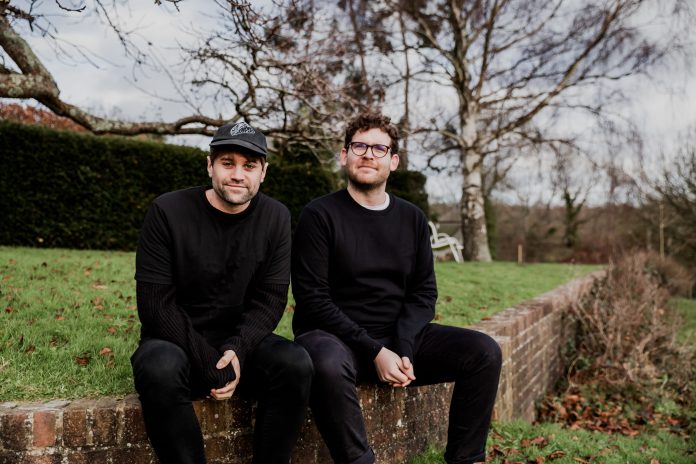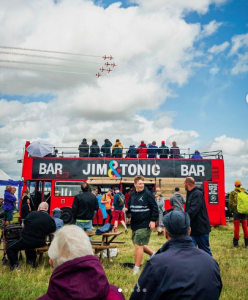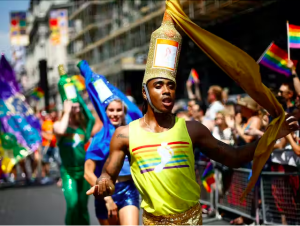Togather, the conflation of the words gather and together is one of those names that you probably wish you’d thought of when considering company nomenclature for the festival industry. It took founders Digby Vollrath and Hugo Campbell several years of trading, growth and investment as Feast-It to make the switch that better fits what their F&B finder has become.
Fresh from an $8.5m investment round, we caught up with Digby to chart the trip from concept through to growth beyond initial expectations.
Middle man? Broker? Agent? Facilitator? Introducer? Describe Togather.
“We’re a marketplace that, essentially, connects the best independent suppliers in the events industry with organizers. We do that across two different categories; one is large scale festivals and public facing events. For us, that’s everything from, say, last weekend we just wrapped up with Krankbrothers in Finsbury Park, we did London Pride this year, we did Gala Festival in South London. So, across the country it’s working with large scale events like that.
“We also have an arm of the business that focuses on corporates and smaller, more private events as well. On that side of it, essentially what we’re doing is taking thousands of the best independent street food traders, photographers, marquee businesses, staffing agencies, vetting them and essentially creating a pool of the best talent that’s easy for those organizers to access.”
All the best businesses start with a good idea, How did that come about?
“My flatmate, Hugo and I at the time had [the idea]. My background prior to this was in the events industry, it’s always the sector I’ve worked in, starting with a music blog – I kind of used that as my excuse to get free tickets from probably a lot of your readers. My first proper job was out in the States. I worked for the Smithsonian in DC on their events team out there and then had a job working for a spin out of the UK government focused on throwing large events across Western states, essentially promoting UK bands and talent. We did stuff like flying over the Horrors to do a one off gig at an abandoned church in LA, so just helping promote up and coming bands, British bands into the States. I then moved back to the UK to work for Festicket. Across all of that I kind of saw a common set of pain points. A lot of people were doing innovation around ticketing and how to sell more tickets or how to help organisers engage with audiences, but not a huge number of people were building platforms that helped people put on those events, actually streamlining parts of that. The space that we really understood well was food and drink.
“We thought we could combine the stuff that we’d learned from the data and technical side of the ticketing market and apply that to helping people organise their events and bring in the suppliers, essentially putting those two things together, that’s really where the idea came out from.”
It all started with food, hence the original name, Feast-It?
“Yeah, food is our bread and butter, that is what we’ve started out with and that’s what we’ve always done. We started just growing out pretty organically beyond that. In our second year, people just kept on asking us for photography recommendations and we built up a pool of photographers and it felt really logical to build them on site.
“Similarly we were finding that people were trying to book venues through us. So we thought, let’s launch venues on the platform. So it’s been a pretty organic growth.
At the moment we now do food, drink, photography and venues; they are kind of the core verticals that we’re in, we’ve kind of grown out across those and this was why the name’s changed, we grew from doing more than just food, but also actually because it was never a particularly good name. Now there’s more than 70 people in the team and if you’d ever told us that’s the size we’d get to, we probably would have thought a bit longer about [the name]. It’s essentially the brand catching up with where we’ve ended up as opposed to making some kind of big statement.”
You’ve recently announced a fairly significant investment.
“We’ve done a couple of round investments over the last few years, one was during the pandemic. We managed to find a cohort of investors who didn’t believe in that shift to virtual, that everything was going to be online. We found investors who who really bought into the concept that the live economy was going to come back bigger and better than it ever had been pre-pandemic, which is obviously something we’ve all seen play out.
“Obviously, similar everyone in the sector, we were really negatively affected during that period, so that series of investors, the same people who backed us again post pandemic.
It’s individuals but also some institutions, but it’s really people who always believed that the live economy would be a booming part of the national economy and just thought it wasn’t that, which most VCs were backing during that lockdown, isn’t the vision for the future they wanted or they thought that we were building towards. “
You found investors that were confident in both you and the sector?
“I definitely think we’re there’s a sector of investors that we were not the right fit for, at the last at the last round of funding we probably turned down as much as we took on. You know, we didn’t want to raise more than we needed.
“But and also on top of that, we didn’t want to work with the wrong partners, we turned down a lot of people who want to put capital in and took money from people who care about the sector. Part of it is how someone described to me that taking on investment is essentially a ten-year marriage that I can’t ever afford to divorce from. So, in that sense of it, you’ve got to find people you want to work with who believe in what you’re trying to build a solution for.”
The latest round, $8.5m, what does that mean to you and what does it mean to users?
“It’s probably something that makes us slightly different from most businesses in the event sector and how we operate. We’re a tech company, and, essentially, what that money goes towards, is R&D and building out our tech product. Our largest spend per month is on engineering talent and people who are building the platform.
“For the suppliers, what we’re really trying to build for them, what we’ve always been, is essentially an acquisition channel. So we get a bunch of events in the platform they bid to, they create quotes, put those quotes in front of the customer, the customer can go through it. We really streamline that process for them.
“What we want to do is build a deeper relationship with our suppliers; give them more tooling that can help them grow their businesses. The comparison I often try and make is that it’s similar to what someone like Shopify has done for small retailers, where it’s given them the rails to become a digital business.
“What we want to do is give these small independent event supply businesses the rails to get online. This sector is 99% mom and pops; it’s the street food traders, the independent photographer, it’s the small venue, that’s 99% of this industry. For them, what we’re trying to do is build out this acquisition channel, [so they can] get better at acquiring customers, give them easier ways to find the best customer for them.
“More than that is giving them more and more tooling; giving them things like calendars so they can manage their entire businesses calendar through our platform and streamline that process. We’re building our AI that’s going live at the end of this week, which is using AI to better do that matchmaking, so it could look at who that supplier normally wins business off and can we make sure we’re only matching them with the kind of customers that they want to be at? On the festival side of it, it’s if a supplier is always bidding to be at certain types of events, but they’re never getting picked by an organizer for that event, can we take that information and help match that supplier better and better to the right kind of events?
“Then it’s other things beyond that, can we build out better perks, can we go and do relationships with insurers etc, and give them a bigger suite of tooling? That essentially means that what those small business can do is focus on what they’re really good at, which is delivering amazing experiences and actually worry less about those aspects of the business that we can help them with.
“The other side is the customer side, for them its similar. We want to become a more and more integrated tool that basically let people streamline, help people throw events more easily. We’re experts in a couple of things and we really help those organizers deliver those things more simply. So we want to help them find more supply, better suppliers and to become a more integrated, more streamlined part of that process for them.”
The obvious question: How do you make money?
“It’s a good question, because it’s probably what makes us different from other tech platforms in this space. Some of them use pay per lead where the supplier has to buy like buy the lead off you. We don’t work like that, we’re commissioned we take a fee. It’s basically no win, no fee.
“For a festival organizer, we’re taking a percentage of the sales. So if we deliver a bad experience and your sales don’t increase, we don’t make any money. If we deliver a great experience and your sales at that event increase through F&B, we make more money. So we are aligned with the organizer.
“It’s the same with the supplier, the suppliers don’t have to do anything for us, there’s no obligation. They don’t have to quote for all events, there’s no exclusivity.
“Essentially, we only drive value when both parties are happy. That’s great for us because it means the better the job we do, the more we make in revenue. But it’s also good for both parties because, theoretically, all three of us have to be happy for anyone to benefit.”
Now the stupid question: Why not just use Google?
“What we’re trying to do is build something that’s curated, so we let on about 1 in 20 suppliers who apply to get onto the platform. We’ve always taken this logic that we’re curated but not snobs, which mean that we’ve got £5 a head hamburgers alongside £250 a head sushi, that’s the full scale of budget friendly through to incredibly expensive, both sit on our platform. But, in each of those categories, they have to be exceptional at what they do. We’re an arbiter of exception.
“There’s not a single supplier on our platform that’s ever received lower than a four star review for a single booking they’ve done with us. That that would put a strike against supplier in that they’d go into a process against that.
“For us, it’s really about what we do that Google doesn’t do, we put it all into one place for you. You can create an event on our platform that takes you probably about two minutes; within about an hour, you’ll start getting inbound quotes from suppliers. You actively want to do your event, which means that they’ve got availability, they’re available for the budget, they’re available for that location, they actively want to trade at your event. And then on top of that, every single one of those suppliers will be curated, which means that they should be delivering a fantastic experience. So it’s ease and simplicity. We remove that pain point from it.
“And then the second [difference] is also it’s that curation. I guess it’s similar to the reason that you’d go to a Booking.com or another kind of marketplace in a different part of your life. It’s that same kind of ease that we’re giving you across that essentially.”
From a festival perspective, do you find that you’re filling gaps in provision or are you providing a full-spectrum F&B offer?
“For festivals, we would normally be doing either all of the food or all of the food and drink, and that tends to be what festivals use us for. We don’t do a huge amount of photography and wwe’re not helping the festival find a venue. Most of the festivals are working with a fairly established. So that side of the festival is really what we’re kind of known for and what we where we drive the most value for most festival organisers is in our kind of niche around food and drink.”
You’ve probably partly answered this already, but is the business where you imagined it would be when you when you first sat there in your shared flat working on the idea?
“It’s definitely bigger. We honestly had a moment when, over the course of July and August, we’d had something like two and a half, 3 million people go to an event that we’ve been involved in. You never expect that, right?
“I think we kind of think the first booking we ever had was my sister’s wedding. I think we were pretty happy with that, that felt like a good result. That was 150 people. So, yeah, you hit a different scale. I think for us, we’re, really proud of what we’ve got and think it is a different size than we ever expect it to be.
“I think the thing that we found is that we keep growing. We’ll grow more than two times this year in terms of customers; last year we had 140,000 people create an event on our platform this year we’ll probably get north of 200,000 in terms of the number of people, and we’ll do more than two times the number of events. Our suppliers will probably quote about half a million times from our platform this year. So something’s clicking. And I think that kind of gives us the energy.
“I think most, something that probably resonates with most people in this space [is that] you’re always trying to work out how you make next year’s event better. You know, as soon as one festival wraps, you’re excited about what do we do differently next season? And I think that we have that similar kind of mindset.”
Aside from the spreadsheet and return for investors, what’s your measure of success for the business?
“We have two sets of metrics. Which is like, you’re right, there’s the one that is the spreadsheet, which, fundamentally, pays the bills. We’ve got 70 people on payroll, so that matters, that’s definitely a metric that we measure ourselves against.
“The other is like a pretty techie metric, which is NPS, the Net Promoter Score, which is what’s your average review that you get from someone who uses you. We break that into pure NPS and then retention. For us our customer NPS at the moment is about 80; anything above 60 would be deemed exceptional, hat’s the equivalent to about it’s about a 4.9 out of five would be your average review for you to be getting around that kind of score. That’s something that we want to keep up, I think a lot of businesses when they scale, that can suffer. That’s something that’s really important to us, is that that continues to stay where it is and ideally grows the same for the other side of the market.
“It’s equally important that the suppliers love us because without, it’s like having a car with no petrol, or having petrol, and no car; you need both sides of both sides of the equation.
“Another is retention. And I think this year to date 90% of the contracts that we have renewed with us. And so again, clearly you’re doing something right, if 90% of people are coming back and saying, ‘ee want to work with you guys again’. In most of those instances, they’re signing multi-year extensions to those contracts. Something we’re doing is clicking and that that’s where the proof is.
“For us, those two things are alongside the financial metrics, the two things that really drive us.”
Passion is what drives the events business. That passion leads most to become either organisers or suppliers. In Togather’s case, it has led to a business that sits firmly in the middle, earning its keep through constant development, an eye for excellence and the ultimate aim of making both sides of the sector operate as efficiently and painlessly as possible.








